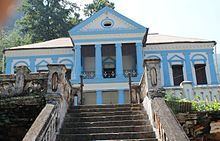Cost Unknown Structural system Brick and Mortar | Completed 1893 Client Khadga Shumsher JBR Opened 1893 | |
 | ||
Similar Rani Mahal, Kanjiroba, Boudhanath, Kathmandu Durbar S, Swayambhunath | ||
Troll wars ranighat palace
Rani Mahal (Nepali: रानी महल) is a Rana palace located in the banks of Kali Gandaki River in Palpa district of Nepal. This palace was constructed by General Khadga Shumsher JBR in 1893.
Contents
History
In 1887 General Khadga Samsher Rana was forced to drop his royal titles and was sent to Palpa-Gauda as the Western Commander in Chief of Nepal. At Palpa-Gauda in 1892 Khadga Shumsher's beloved youngest wife Tej Kumari Devi died and within a year Khadga built a palace and named after his wife as Rani Mahal (Literary translates as Queens Palace). He also named the nearby forest as Rani Ban (Rani forest) along with naming the Ghats as Rani Ghat. In 1902, Khadga Samsher Rana along with his family fled from Nepal to India abandoning Rani Mahal which resulted in negligence of Rani mahal and eventually this palace structure started crumbling.
Current Status, Reconstruction & Restoration
As the Khadga Shumsher abandoned the palace and fled to India, Rani Mahal was left behind without any proper owner or caretaker. The condition of the palace was a concern of both the government of Nepal and locals. Rani Mahal was largely turned into rubble by the end of 20th century. Very few visitors used to visit the palace, only those most interested in the history of Nepal.
At present, the Government of Nepal has started a reconstruction and restoration program to repair and rebuild the palace to its original state. This will not only preserve the national historical properties, but also increase the possibilities of tourism in the area and result in various developments.
Access
Currently, there is no motorable road to Rani Mahal. A foot trail from Kailashnagar near the Batasedanda, about 3 km from Tansen leads to Ranimahal. It takes about 3-4 hrs walk to reach Rani Mahal from Batasedanda.
Legacy
Rani Mahal is considered as the "Taj Mahal of Nepal" due to its relative location in Kalighandaki River over a huge rock.
